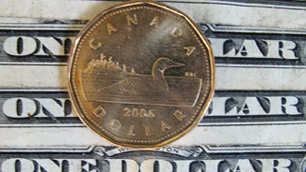Loonie reaches U.S. parity
 The loonie reached par with the U.S. dollar early Tuesday, and continued trading around that level through the day before closing below parity.
The loonie reached par with the U.S. dollar early Tuesday, and continued trading around that level through the day before closing below parity.The Canadian dollar first reached $1.0001 US, up .29 of a cent, at 6:48 a.m. ET, and traded above and below that level through the day. Its official close Tuesday was 99.88 cents US, a gain of .16 of a cent on the day.
The loonie hadn’t traded at or above parity with the U.S. dollar since July 2008. It surged as high as $1.10 US in November 2007 as oil prices soared above $100 US a barrel. By March 2009, it had tumbled back to 76 cents US before staging its latest comeback.
Scotia Capital economists Derek Holt and Karen Cordes said in a commentary Tuesday the catalyst for the advance was a delayed reaction to U.S. employment data from Friday — suggesting a strengthening recovery — as well as optimism about a pending data on U.S. home sales and services-sector employment.
The economists also said Australia’s decision to increase its benchmark interest rate Tuesday by a quarter percentage point to 4.25 per cent “has markets reinforcing bets that the [Bank of Canada] is next.”
Possibility of $1.05 or $1.06 US
Holt told CBC News he expects the Bank of Canada will increase rates before the end of June. If that happens, and oil prices move to $100 US a barrel by the fall, he said, the Canadian dollar could rise five to six cents above the U.S. currency.
Holt said the loonie is benefiting from an appetite among global investors for the currencies of countries with relatively low debt, political stability and with central banks focused on keeping inflation under control
“Canada scores highly on those counts,” he said, “but at the same time if you are looking at exposure to an economy that could benefit from upside global growth surprises and further commodity price increases then there, too, the Canadian dollar wins. So really it’s a win-win on both counts.”
The last time the loonie eclipsed the U.S. dollar, there were dire predictions for Canada’s economy that largely didn’t pan out.
Manufacturers tend to be hardest hit, but after years of outsourcing to cheaper alternatives, manufacturing now only represents 13 per cent of the Canadian economy, down roughly five basis points over the past decade, Scotia Capital noted.
“A strong Canadian dollar isn’t anywhere nearly as damaging to the economy as often portrayed,” they said, largely because most companies already employ currency hedging to mitigate harm. And a strong loonie ultimately means a funding advantage for many Canadian firms, as it cheapens the cost of capital to invest in businesses.
The U.S. dollar has been driven down in recent weeks by rising oil prices and continued economic instability.
Economists don’t expect the loonie to rise quickly to the heights it reached in November 2007, but rather expect it will waver around parity for a while.
Read more: http://www.cbc.ca/money/story/2010/04/06/loonie-parity-rise.html#ixzz0kPxRvcQR
You can return to the main Market News page, or press the Back button on your browser.

